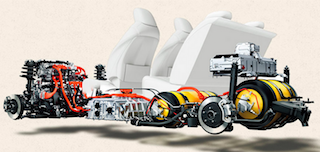C.6 Electrochemistry, rechargeable batteries & fuel cells
Written specifically for students to provide help and support for the IB Diploma chemistry programme this page provides full coverage of the syllabus content of Option C - sub topic C.6. It encourages you to think critically and provides many questions with full worked answers so that you can monitor and improve your knowledge and understanding.
.png)
 Learning outcomes
Learning outcomes
After studying this topic you should be able to:
.png) Understand:
Understand:
- Electrochemical cells have internal resistance because of the finite time it takes for ions to diffuse.
- The internal resistance of a cell limits the current it can produce.
- The voltage of a battery primarily depends on the type of materials used, while the total work output depends on their quantity.
- In primary cells the electrochemical reaction is non-reversible. Rechargeable cells involve redox reactions that can be reversed using electricity.
- Fuel cells convert the chemical energy that is contained in the consumed fuels directly into electrical energy.
- Microbial fuel cells, MFCs, which use different carbohydrates or substrates present in waste waters as the fuel, are a possible sustainable energy source.
- The potential of a half-cell under non-standard conditions can be calculated from the Nernst equation:

- Concentration cells contain the same electrodes but the concentration of the electrolyte solutions at the cathode and anode are different.
- Distinguish between fuel cells and primary cells.
- Deduce the half equations for the electrode reactions in a fuel cell.
- Compare fuel cells with rechargeable batteries.
- Discuss the advantages of different types of cells in terms of size, mass and voltage.
- Solve problems using the Nernst equation.
- Calculate the thermodynamic efficiency (ΔG/ΔH) of a fuel cell.
- Explain the workings of rechargeable batteries and fuel cells (including diagrams and relevant half-equations).
Relationships & vocabulary
Nature of science
Redox reactions can be used as a good source of electricity but the disposal of batteries can cause environmental problems.
International-mindedness
The ways in which spent batteries are disposed of and/or recycled vary from country to country.Vocabulary
| Nernst equation | microbial fuel cell, (MFC) | proton exchange membrane (PEM) fuel cell |
| concentration cell | lithium-ion battery | nickel-cadmium (NiCd or NiCad) battery |
| lead-acid battery |
Learning slides
You can use this slide gallery for learning or for reviewing concepts and information. It covers all the key points in the syllabus for this sub-topic.
Something to think about
The first crude fuel cells were actually invented as long ago as 1838 by William Grove, a Welshman and independently by Christian Schönbein from Germany.
It was the NASA space programme that really developed them to become a viable technology. The space shuttle contains three fuel cells, which operate as independent power sources. These use oxygen and hydrogen gas and an electrolyte of potassium hydroxide. Each one is capable of supplying 12 kW peak and 7 kW maximum continuous power supply which is ample for the average power consumption of the shuttle. As well as providing electrical power and heat, the product, water, is used by the astronauts for drinking.

Cut-away of the Toyota Mirai showing the fuel cell stacks beneath the driver and passenger seats and the yellow hydrogen fuel tanks in the rear.
Only now are fuel cells being seriously used to power cars. The Toyota Mirai, has a range of 312 miles (502 km) from a full tank. The first cars went on sale in the US in August 2015 at a basic cost (before any government subsidies) of $57 500. The relatively high cost and the current lack of hydrogen fuel stations are two initial hurdles that will need to be overcome. Ultimately vehicles powered by fuel cells (FCVs) may well prove to be the best answer to providing transport for the masses that does not rely on fossil fuels and so significantly reduce the emission of polluting greenhouse gases.
Test your understanding of this topic
(Note that your teacher may have restricted your access to some or all of these questions and worked answers if they are going to use them as a class test or set them as an assignment.)
For ten 'quiz' questions (for quick testing of knowledge and understanding with the answers explained) see MC test: Electrochemistry, rechargeable batteries & fuel cells.
For short-answer questions see Electrochemistry, rechargeable batteries & fuel cells questions together with the worked answers on a separate page Electrochemistry, rechargeable batteries & fuel cells answer .
More resources
1. A good description by BASF on how lithium-ion batteries work.
![]() How lithium-ion batteries work
How lithium-ion batteries work
2. Another good description - this time on how a lead-acid battery works by Bill Hammack from the University of Illinois.
3. An animated overview of fuel cells by the Naked Science Scrapbook which provides a good introduction to the different types of fuel cells and why they are useful (but does not include the half-equations).
4. This American Chemistry Society video shows how waste water can be used to produce electricity using microbial fuels cells.
![]() Using microbial fuel cells to generate electricity
Using microbial fuel cells to generate electricity

 IB Docs (2) Team
IB Docs (2) Team 






















